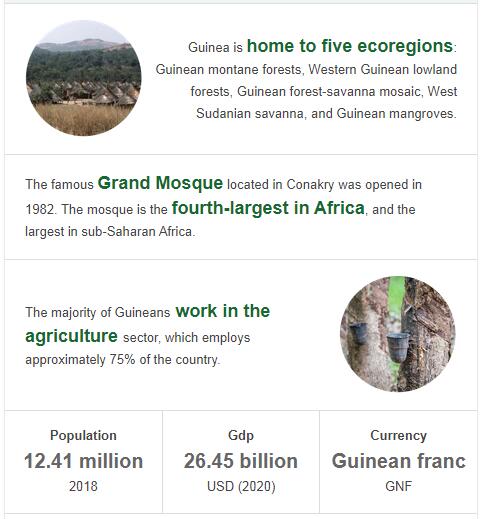The population of Guinea in 2017 was 12.7 million people, with the majority living in rural areas. The economy of Guinea is largely based on services, industry, and agriculture, with a GDP of $10.5 billion and a relatively low per capita income. Guinea is a member of the United Nations, Economic Community of West African States (ECOWAS), African Union (AU) and Mano River Union (MRU). It has close ties to many countries throughout West Africa as well as its former French colonial masters. In terms of politics, it is a unitary presidential republic with President Alpha Condé as its head of state. The Prime Minister is Ibrahima Kassory Fofana who leads the Rally of the Guinean People party which has been in power since 2010. See militarynous for Guinea military and defense.
Yearbook 2017
Guinea. In February, a strike broke out among the country’s teaching staff since the government decided to lower the salaries of several teachers. The protests were supported by many students and led to several clashes between students and the military police in the capital Conakry. The violence resulted in five people being shot to death. The strike was canceled after an agreement was reached between the government and the teachers. Later that month, President Alpha Condé dismissed three ministers as a result of the events. See ABBREVIATIONFINDER for frequently used acronyms and abbreviations related to as well as country profile of Guinea.
According to Countryaah.com, promises from October 2016 that local elections were held in February 2017 were never fulfilled, even though such elections have not been held since 2005. The promised new electoral law and updated voting lengths have also not come into place. This prompted several thousand opposition supporters to walk the streets of Conakry in August to demand that the local elections be conducted. In September, the country’s Election Commission announced that local elections will be held on February 4, 2018, a date approved by President Condé in early December.
In September, unrest also erupted in the mining town of Boké in western Guinea. The city is located in a bauxite-rich area and among the population there is dissatisfaction that the income from the mining industry does not benefit the city’s residents. The direct cause of the protests was the recurring electricity outages. The local office of the RPG’s (Guinean People’s Union) local offices was destroyed and parts of the city were occupied by armed youths. Looting of shops occurred, as did vehicle vandalism. At least fifty people were injured and two deaths were reported.
Climate
In Guinea there is a tropical alternating climate with rainy and dry seasons of different lengths from region to region. On the coast it is hot and humid with high precipitation, east of the Fouta-Djalon plateau the precipitation is falling. The precipitation of the West African monsoons falls between April and November with tropical thunderstorms and violent storms; in the southern rainforest areas they usually begin in February. The peak of the monsoons is reached in July and August. The dry season is from November to April. During this time the country is under the influence of the north-east trade winds Harmattan from the Sahara.
Temperatures in Guinea average 22 ° C to 32 ° C, the maximum temperatures are between 28 and 35 ° C. In the Fouta Djalon plateau, the lowest winter temperatures are 6 ° C. In the capital Conakry on the Atlantic coast, regardless of rainy or dry season, there is an almost constant temperature between 24 and 32 ° C day and night, the annual rainfall in Conakry is more than 4,000 mm. Due to the high humidity (up to 98 percent), the climate is perceived by visitors as muggy and very tiring. The months at the beginning and end of the rainy season (May / June and October / November) with tropical thunderstorms, hurricane-like storms and downpours are particularly unfavorable.
